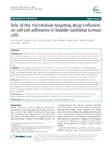Role of the microtubule-targeting drug vinflunine on cell-cell adhesions in bladder epithelial tumour cells

View/
Use this link to cite
http://hdl.handle.net/2183/19435Collections
- Investigación (FCS) [1293]
Metadata
Show full item recordTitle
Role of the microtubule-targeting drug vinflunine on cell-cell adhesions in bladder epithelial tumour cellsAuthor(s)
Date
2014-07-10Citation
Aparicio LA, Castosa R, Haz-Conde M, et al. Role of the microtubule-targeting drug vinflunine on cell-cell adhesions in bladder epithelial tumour cells. BMC Cancer [Internet]. 2014 Jul 10 [acceso 2017 Sep 5]; 14:507. Disponible en: https://bmccancer.biomedcentral.com/articles/10.1186/1471-2407-14-507
Abstract
[Abstract]
Background. Vinflunine (VFL) is a microtubule-targeting drug that suppresses microtubule dynamics, showing anti-metastatic properties both in vitro and in living cancer cells. An increasing body of evidence underlines the influence of the microtubules dynamics on the cadherin-dependent cell-cell adhesions. E-cadherin is a marker of epithelial-to-mesenchymal transition (EMT) and a tumour suppressor; its reduced levels in carcinoma are associated with poor prognosis. In this report, we investigate the role of VFL on cell-cell adhesions in bladder epithelial tumour cells.
Methods. Human bladder epithelial tumour cell lines HT1376, 5637, SW780, T24 and UMUC3 were used to analyse cadherin-dependent cell-cell adhesions under VFL treatment. VFL effect on growth inhibition was measured by using a MTT colorimetric cell viability assay. Western blot, immunofluorescence and transmission electron microscopy analyses were performed to assess the roles of VFL effect on cell-cell adhesions, epithelial-to-mesenchymal markers and apoptosis. The role of the proteasome in controlling cell-cell adhesion was studied using the proteasome inhibitor MG132.
Results. We show that VFL induces cell death in bladder cancer cells and activates epithelial differentiation of the remaining living cells, leading to an increase of E-cadherin-dependent cell-cell adhesion and a reduction of mesenchymal markers, such as N-cadherin or vimentin. Moreover, while E-cadherin is increased, the levels of Hakai, an E3 ubiquitin-ligase for E-cadherin, were significantly reduced in presence of VFL. In 5637, this reduction on Hakai expression was blocked by MG132 proteasome inhibitor, indicating that the proteasome pathway could be one of the molecular mechanisms involved in its degradation.
Conclusions. Our findings underscore a critical function for VFL in cell-cell adhesions of epithelial bladder tumour cells, suggesting a novel molecular mechanism by which VFL may impact upon EMT and metastasis.
Keywords
Microtubule
Cell-cell contacts
E-cadherin
Vinflunine
Bladder cancer
Cell-cell contacts
E-cadherin
Vinflunine
Bladder cancer
Editor version
Rights
Atribución 3.0 España
ISSN
1471-2407






